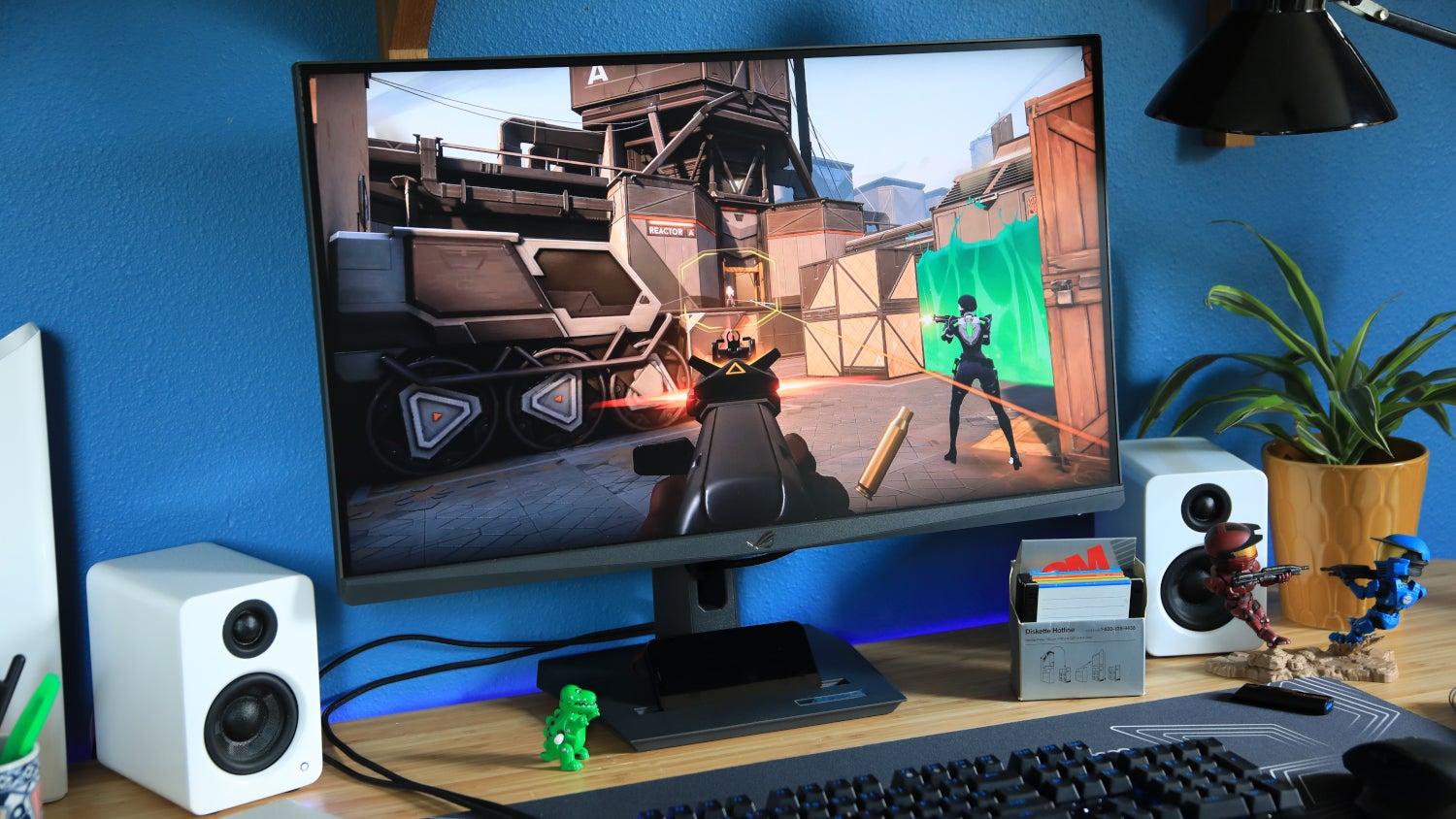Gamers looking to buy a 27-inch 1440p gaming monitor for less than $300 are spoiled for choice this year with more than half a dozen viable options from Acer, Samsung, Dell, LG, AOC, Gigabyte, and more. Asus muscles into this pack with a monitor that’s mostly unsurprising but leans on the company’s proprietary backlight strobing to gain an edge in motion clarity.
Asus ROG Strix XG27ACS – Design
The Asus ROG Strix XG27ACS is similar to most other ROG Strix monitors, and that’s a good thing given its low price. It makes use of sturdy charcoal-colored plastics that provide solid build quality, and the design is attractive without going over the top. From the front, it has slim bezels on three sides and a modestly-sized chin on the bottom. From the back, it uses subtle etching in the plastic to present the ROG logo and a few cyberpunk-style design flourishes.
A few cuts are made to keep the price in check. The monitor lacks any form of RGB LED lighting to spice up your desktop. It also feels relatively thick for a modern monitor, which hints towards its budget price tag and use of a conventional IPS LCD panel with an edge-lit backlight. I don't think Asus's design is as attractive as Dell's inexpensive G-series gaming monitors, or Samsung's Odyssey G5 line, but it's only a step behind.

The monitor does retain one very important feature: an ergonomically adjustable stand. It adjusts for height, tilt, and swivel, and pivots 90 degrees for use in portrait orientation. Height adjustment is limited to a total of 120mm, while some alternatives can go up to 150mm, but that's understandable given the price. The monitor is also compatible with 100mm x 100mm VESA mounts if you'd like to use a third-party monitor stand or arm.
Asus rounds out the monitor’s design with a small trench in the stand that’s meant for use as a smartphone stand. I doubt many gamers will care for this feature, but it’s available should you choose to use it. As an added bonus, the monitor has a tripod mount at the top of the stand, which might be useful if you want to mount a webcam for streaming. That’s a rare feature at this price.
Asus ROG Strix XG27ACS – Connectivity & Features
The Asus ROG Strix XG27ACS stands out from the competition in connectivity. It has a USB-C port with DisplayPort Alternate Mode alongside one DisplayPort 1.4 and one HDMI 2.0. That’s a total of three video inputs, giving the monitor a broad range of connectivity options for use with laptop and desktop PCs, as well as a game console. Most budget gaming monitors have yet to leap to USB-C, so it’s nice to see here.

But don’t get too excited. It only provides up to 7.5 watts of power delivery, so it’s not going to be useful for charging any laptop, much less a gaming laptop. There’s also no downstream USB support for connecting a wired keyboard or mouse, so the monitor doesn’t function as a USB hub. These omissions are not surprising given the monitor’s low price point but are important to keep in mind. The USB-C port is really just for video input and not for data or charging.
The monitor’s on-screen menu system is controlled through a joystick or can also be accessed through a software called DisplayWidget that is available from Asus. The monitor’s menus are easy to access and provide a good range of image quality customization that includes several color temperature presets and gamma presets, which target precise gamma curves. This is becoming fairly common among even budget gaming monitors, but it's still good to see.
Asus ROG Strix XG27ACS – Gaming Image Quality
At a glance, the specifications of the Asus ROG Strix XG27ACS don’t promise great image quality. The monitor has a 27-inch IPS panel with a standard edge-lit backlight and a resolution of 2560 x 1440 at a maximum refresh rate of 180Hz. There's no fancy mini-LED or quantum dots here. Even so, the monitor’s quality is good for the price.

Color performance is a strength. The monitor has good color accuracy and provides a color gamut that covers up to 100% of sRGB and 91% of DCI-P3. Games look colorful, vibrant, and realistic, especially in bright and highly saturated scenes. Games like Overwatch 2, Forza Horizon 5, or Stardew Valley all look excellent on the XG27ACS. The monitor also has a high maximum SDR brightness of 406 nits, so the display can deliver a punchy and bright presentation even when used in a brightly lit room. The matte screen coating helps, too, by ensuring glare isn't an issue.
Contrast performance is also good for an IPS display, with a maximum contrast ratio of 1360:1. That's definitely better than most monitors in this category, as a contrast ratio closer to 1000:1 is more typical. I’m not sure this improvement is noticeable, however, as the monitor still suffers from the “IPS glow” problem, which causes darker scenes to look hazy and gray. If you prefer darker games like Diablo IV, Darkest Dungeon, Resident Evil: Village, you may want to opt for a monitor with a VA panel, as they deliver better contrast for the price.

Sharpness is a positive, as the monitor’s 2,560 x 1,440 resolution, spread across a 27-inch display, translates to a pixel density of 109 pixels per inch. While that's not close to the 163 PPI you’d get on a 4K monitor of the same size, it still offers a sharp, crisp presentation in most games. Players will only notice aliasing or stair-stepping artifacts in games that have a subpar anti-aliasing implementation.
On the whole, the XG27ACS is a good pick if you want a budget gaming monitor that offers a bright, colorful presentation with respectable sharpness. However, while its performance is better than average, it does face significant competition. Alternatives like the Dell G2724D, Samsung Odyssey G5, and AOC Q27G3XMN deliver similar or better performance, and some do so at a lower price.
Asus ROG Strix XG27ACS – HDR Image Quality
The Asus ROG Strix XG27ACS is VESA DisplayHDR 400 certified, so you might think that it's a decent pick for HDR content. Unfortunately, that's not the case. The monitor does support HDR and delivers the brightness it claims, but it still falls short.
Contrast is a major issue. As mentioned, the XG27ACS has a standard edge-lit backlight, which means it isn't capable of turning off portions of the display to improve contrast between bright and dark areas. That means scenes with brighter objects will tend to also elevate the brightness of dark areas of the screen, which creates a flat and washed-out look. When viewing the black hole escape scene from Interstellar, for instance, I noticed that there was a significant lack of detail in the massive disc of swirling hot gasses around the black hole, as well as the bright blue thrust emitting from behind the spaceship.
To be fair, most of the monitor’s competitors also can't deliver a good HDR experience – it's just not available in this price range. Gamers who want great HDR will need to spend more for an OLED or, preferably, a Mini-LED display.
While HDR isn’t great, I do appreciate Asus’ inclusion of an “adjustable brightness” mode. Gamers who’ve yet to try an HDR monitor might be surprised to learn most HDR monitors disable brightness adjustment when the mode is activated. That can prove annoying, so it’s great to see Asus enable adjustable brightness in HDR.
Asus ROG Strix XG27ACS – Motion Performance
Make no mistake: motion performance is the reason to buy the Asus ROG Strix XG27ACS. That might seem surprising given its maximum refresh rate of 180Hz, which isn't all that impressive in 2024, when 240Hz monitors (and faster) are becoming more widely adopted. However, Asus includes a feature that gives it an edge: Extreme Low Motion Blur (ELMB). This is Asus' proprietary backlight strobing technology, designed to reduce motion blur by strobing the backlight at a very high frequency. This, thanks to some quirks of the human eye, reduces the perception of motion blur.
Backlight strobing is still uncommon among budget gaming monitors (though some competitors do have it), but what sets ELMB apart from Asus’ competitors is compatibility with Adaptive Sync. While Nvidia recently announced an initiative to make this more common, it’s still pretty rare. Budget gamers usually have to choose between better motion fluidity and motion clarity. With the XG27ACS, you can get both.
Clarity is impressive with ELMB turned on. The refresh rate may only hit 180Hz, but with this feature enabled, it looks more like a 240Hz monitor. Even small, fine elements like text and hit points bars are easy to make out as they scroll across the screen at high speed. ELMB also shows less of the “double image” effect that can be noticeable with some competing backlight strobe implementations. Preferences vary here, however, so gamers allergic to the “double image” effect should still be wary.

There are some limitations. ELMB can't be used with the aspect ratio customization options on the monitor, or with the low blue light mode. It also reduces the maximum brightness of the display. But, in general, it's usable enough that I would recommend anyone owning this monitor to turn it on immediately. ELMB’s benefits are also more tangible in games with a lot of small, fine text and frequent movement, like League of Legends. If you instead prefer Civilization VI, well, you’re unlikely to notice or care about the improvement.
Asus deserves credit for officially supporting both AMD FreeSync and Nvidia G-Sync. Most modern monitors that support Adaptive Sync should work with both and function without issue in nearly all cases, but it's still good to see support officially listed so that shoppers are not confused by the monitor's capabilities.
The great motion clarity the XG27ACS delivers with ELMB on makes it an obvious choice for competitive gamers and anyone who cares about image quality in motion. It's the key reason to buy the XG27ACS over Asus' competition.
Asus ROG Strix XG27ACS – Day-to-Day Use
Although primarily designed for gaming, the Asus ROG Strix XG27ACS is a good monitor for general day-to-day productivity. It has the brightness and sharpness needed to make text easy to read and to deliver an attractive image when browsing the web, watching YouTube, or working in Microsoft Word. This is all basic stuff, but some budget gaming monitors, especially those that stick to 1080p resolution, can have issues here.
The XG27ACS finds its limits in content creation. 1440p resolution is high enough to look sharp, but it means you're not going to be able to view a 4K video file at its native resolution, which is a problem for video editors and may also be a problem for professional photographers. And while HDR is supported, it doesn’t look great, so you're not going to want to work with HDR content on this monitor.
Asus ROG Strix XG27ACS – The Competition
The Asus ROG Strix XG27ACS has many competitors, including the Acer Nitro XV271U, LG 27GL83A-B, Samsung Odyssey G50A, Viewsonic OMNI VX2718-2KPC-mhd, and Dell G2724D.The XG27ACS is a bit more expensive than these alternatives and delivers similar image quality, but it has an edge in motion clarity and the included USB-C port. Gamers who don’t see those extras as essential can save a few bucks and stick to the Samsung Odyssey G50A or Dell G2724D, but those who want better motion clarity should spend the extra for the XG27ACS.









